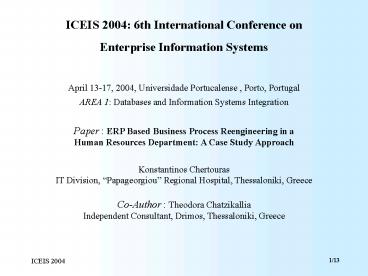ERP Based Business Process Reengineering PowerPoint PPT Presentation
1 / 13
Title: ERP Based Business Process Reengineering
1
ICEIS 2004 6th International Conference on
Enterprise Information Systems April 13-17,
2004, Universidade Portucalense , Porto,
Portugal AREA 1 Databases and Information
Systems Integration Paper ERP Based Business
Process Reengineering in a Human Resources
Department A Case Study Approach Konstantinos
Chertouras IT Division, Papageorgiou Regional
Hospital, Thessaloniki, Greece Co-Author
Theodora Chatzikallia Independent Consultant,
Drimos, Thessaloniki, Greece
1/13
2
Presentation Plan
- Introduction / General Overview and Definitions
- Non ERP Modeling Approach
- ERP Modeling Approach and Merits Obtained
- Conclusions
2/13
3
1. Introduction
- Modern organizations are considered highly
complex networks of business units - Each business unit realizes a part of the
organizations business process - Complexity of business tasks requires computing
power - A common approach tackle the business process
objectives each unit accomplishes with an IT
platform - A common problem a different IT platform for
each unit - A great solution ERP based IT engineering
3/13
4
2. General Overview
- Aim Outline how ERP technology can enhance
productivity - Case Study A multi-departmental organization
- Test Unit The Human Resources department
- Organization Structure Several units including
subunits - Aim Realize the business process and produce the
corresponding business products - Two types of Implementation ERP vs. non ERP
4/13
5
3. Human Resources Department
- Four key business units
- Personnel Administration
- Payroll
- Time Management / Time Evaluation
- Organizational Management
- Massive load of information exchange
- Example Business tasks to be conducted in an
expected/unexpected employee leave
5/13
6
4. Non-ERP Approach
6/13
7
5. Non-ERP Approach Key Issues
- Single point of customer service for each task
- Error prone information exchange among business
nodes - Reduced fault tolerance in case of a node
failure - Global loss of business process coordination if
central node - Nc becomes unavailable
- Employees are totally responsible for the
business - process realization and operate without
control
7/13
8
6. ERP Approach
8/13
9
7. ERP Approach Key Issues 1/2
- A number of significant merits obtained from
the ERP system employment - Increase in both quality and quantity of
information exchanged - A common user interface able to allow business
users to perform a - variety of business tasks without retraining
- Integration e.g. Time manager perform
organizational management - tasks and vice versa
- Transparency e.g. Employees could be served by
more than one - end points
9/13
10
8. ERP Approach Key Issues 2/2
- Fault tolerance is increased
- Consistency is significantly improved
- Workload balancing is finely tuned
10/13
11
9. Conclusions 1/2
- ERP Implementation allowed
- An increase in the performance achieved in terms
of business - process requests served at any given time
period - Better interdepartmental cooperation through the
use of the same - unified IT ERP platform by all team members
- A significant decrease in the number of errors in
the business - process and in the information exchange among
business nodes
11/13
12
10. Conclusions 2/2
- ERP Implementation allowed
- A significant reduction in the workload offered
to the central - coordinator node
- An increase in the systems fault tolerance in
case of business nodes - failures
- Easy adaptation of new business methodologies by
using standard - software engineering procedures
12/13
13
End of Presentation Thank you for your
attention Paper ERP Based Business Process
Reengineering in a Human Resources Department A
Case Study Approach Konstantinos
Chertouras Dipl.-Eng ECE, Tech.Univ.Crete,Greece,
MSEE,DIC, Imp.College, London IT Division,
Papageorgiou Regional Hospital, Thessaloniki,
Greece Co-Author Theodora Chatzikallia Dipl.-E
ng Mechanical Engineer, Aristotle Univ.
Thessaloniki, Independent Consultant, Drimos,
Thessaloniki, Greece
13/13

